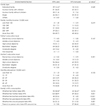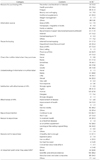Abstract
This study was conducted to identify factors influencing Health/Functional Foods (HFFs) consumption for women in their 20's based on social cognitive theory. A total of 295 subjects participated in this study and were divided into two groups based on the experience of HFF use. This study compared their personal, environmental and behavioral factors which influence the consumption of HFFs. With regard to personal factors, the expected effectiveness for HFFs was higher in the user group than the nonuser group. For the environmental factors, the subjects' use of HFFs was critically affected by the use of HFFs regarding the family members. In terms of behavioral factors, there were no significant differences between the two groups. For the user group, it was observed that their use of HFFs was closely related to when their interests for health was high and the family's use of HFF was high. On the other hands, for the nonuser group, there were less people around them using HFFs than the user group and they did not feel that HFFs were necessary. Since non-experts including parents and close acquaintances critically affected the HFF ingestion of the subjects, it is essential to educate all citizens as well as HFFs consumers about HFFs information.
Figures and Tables
Table 4
Behavioral factors: Diet quality assessed by mini dietary assessment scores in Health/Functional Foods (HFFs) users and nonusers

References
1. Kim SH, Kim HY, Lee SH, Han JH. Use of functional foods for health by Korean: Focused on vitamin and mineral intakes. 2004. In : The Korean Nutrition Society Annual Conference; Seoul: The Korean Nutrition Society;53–56.
2. Moon JS. Domestic health food market analysis and proposed future direction. 2007. Cheongwon: Korea Health Industry Development Institute.
3. Lee JY, Chae SK, Kim KD. The perceptions and purchase intentions of health food consumers. Korean J Food Preserv. 2011. 18(1):103–110.

4. Yoo YJ, Hong WS, Youn SJ, Choi YS. The experience of health food usage for adults in Seoul. Korean J Soc Food Cookery Sci. 2002. 18(2):136–146.
5. Kim SH. A study on the use of health functional foods and its related influencing factors of university students in Korea. Korean J Food Cult. 2010. 25(2):150–159.
6. Kim SH, Han JH, Kim WY. Health functional food use and related variables among the middle-aged in Korea. Korean J Nutr. 2010. 43(3):294–303.

7. Kim SH, Han JH, Hwang YJ, Kim WY. Use of functional foods for health by 14-18 year old students attending general junior or senior high schools in Korea. Korean J Nutr. 2005. 38(10):864–872.
8. Song BC, Kim MK. Patterns of vitamin-mineral supplement usage by the elderly in Korea. Korean J Nutr. 1997. 30(2):139–146.
9. Kim SH, Han JH, Kim WY. Consumption of health functional foods by elementary schoolchildren in Korea. Korean J Nutr. 2010. 43(2):161–170.

10. Han SJ. Perception and consumption pattern of health functional food in female university students [dissertation]. 2011. Seoul: Hanyang University.
11. Lee SS, Kim MK, Lee EK. Nutrient supplement usage by the Korean adult in Seoul. Korean J Nutr. 1990. 23(4):287–297.
12. Kim SH, Han JH, Keen CL. Vitamin and mineral supplement use by healthy teenagers in Korea: motivating factors and dietary consequences. Nutrition. 2001. 17(5):373–380.

13. Cho BH, Chung OB, Yoon GH. Human development: Developmental psychological approach. 1989. Paju: Kyomunsa.
14. 2008 Korean national health statistics. 2008. Seoul: Ministry of Health and Welfare;253.
15. Jo IK. Women's health issues from the 4th Korean National Health and Nutrition Examination Survey (KNHANES)(2007)-Focusing on quality of life, smoking, drinking, nutrition and exercise-. Korean J Womens Health. 2009. 10(1):115–152.
16. Han IK. Analysis on the behavioral patterns related to dietary practice and weight control in different age groups of urban women [dissertation]. 2003. Seoul: Chung-Ang University.
17. Ministry of Health and Welfare, Korea Centers for Disease Control and Prevention. Monthly lying in a sickbed experience rate. 2009. 293.
18. Son IG, editor. 20's no worries? Stress, leading [Internet]. Korea Medicare. 2011. cited 2011 May 6. Available from: http://healthcare.joinsmsn.com/news/article/article.asp?total_id=5452800&cont_code=%20&Cate=&sub=.
19. Øygard L. Studying food tastes among young adults using Bourdieu's theory. J Consum Stud Home Econ. 2000. 24(3):160–169.

20. You SY. Healthy functional food consumption for overweight and obese Koreans. Korean J Community Living Sci. 2009. 20(4):503–514.
21. Chang MK. Assessment of functional food consumption among the working women in Korea [dissertation]. 2007. Seoul: Ewha Womans University.
22. Contento IR. Nutrition education: linking research, theory, and practice. 2007. Sudbury (MA): Jones and Bartlett.
23. Kim HJ. The study about the actual usage condition and purchasing habitus of health/functional foods in female residents of Seoul and Kyeonggi [dissertation]. 2007. Seoul: Yonsei University.
24. Chang YH. A survey on the actual state on use and awareness for health functional foods of female residents in Daegu [dissertation]. 2010. Daegu: Kyungpook National University.
25. Kong TH. Ingestional status of health functional foods of women in Busan and Gyeongnam area [dissertation]. 2008. Busan: Kosin University.
26. Chung SJ. Knowledge and consumption pattern on health functional food of middle aged women in Busan [dissertation]. 2009. Busan: Dong-A University.
27. Lee YJ. Factors influencing purchase and taking functional foods by seniors in Daegu area [dissertation]. 2009. Daegu: Keimyung University.
28. Hyun JS. Influence of self-esteem on social-cultural attitude for appearance, appearance comparison and body image of adolescents [dissertation]. 2007. Jeju: Jeju National University.
29. Kim IS, Yu HH, Han HS. Effects of nutrition knowledge, dietary attitude, dietary habits and life style on the health of college students in the Chungnam area. Korean J Community Nutr. 2002. 7(1):45–57.
30. Kim WY, Cho MS, Lee HS. Development and validation of mini dietary assessment index for Koreans. Korean J Nutr. 2003. 36(1):83–92.
31. Journal of Korean Society for the Study of Obesity. Clinical obesity. Diagnosis and treatment of obesity; Asia & the Pacific guideline. 2000. Seoul:
32. Cash TK, Pruzinsky T. Body images: development, deviance, and change. 1990. New York: Guilford Press;51–79.
33. Kim WY. Nutrition knowledge and food habits of college students. Korean J Nutr. 1984. 17(3):178–184.
34. National major health functional food sales trend analysis and forecasts, consumer awareness and of health functional food. 2010. Seoul: Korea Health Supplement Association.
35. Chang HS, Kim MR. Effect of social-economic factors and related factors of health and life-Style on health foods intakes among the middle aged in the Jeonbuk region. Korean J Community Nutr. 2001. 6(4):617–627.
36. Yi HH, Park HA, Kang JH, Kang JH, Kim KW, Cho YG, Song HR, Lee JS. What types of dietary supplements are used in Korea? Data from the Korean National Health and Nutritional Examination Survey 2005. Korean J Fam Med. 2009. 30(12):934–943.

37. Eldridge AL, Sheehan ET. Food supplement use and related beliefs: survey of community college student. J Nutr Educ. 1994. 26(6):259–265.

39. Yang YJ, Seo HG. A study on the intake of some health food. Inje Med J. 1992. 13(2):221–232.
40. Kim H, Kim M. Investigation for health food intake to prevent damage of the elderly. J Korean Living Sci Assoc. 2006. 15(5):849–858.




 PDF
PDF ePub
ePub Citation
Citation Print
Print







 XML Download
XML Download